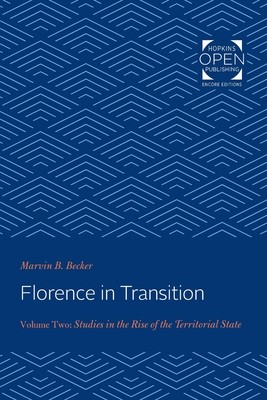
- We will send in 10–14 business days.
- Author: Marvin Becker
- Publisher: Johns Hopkins University Press
- ISBN-10: 1421430339
- ISBN-13: 9781421430331
- Format: 15.2 x 22.9 x 1.7 cm, softcover
- Language: English
- SAVE -10% with code: EXTRA
Reviews
Description
Originally published in 1968. In the pluralistic society of the medieval commune, informal and personal ties of obligation bound men together. In trecentro Florence this "gentle" communal structure gradually evolved into the stricter, more centralized organization characteristic of the modern state. A growing emphasis on law and order transformed the medieval commune of the early fourteenth century into the Renaissance territorial state of the latter half of the century. Professor Becker's subject is this metamorphosis.
Following his study of the declining communal paideia in Volume One, the author examines in this second volume the growing vigor of public world, as well as the attendant depersonalization and repression. He is concerned primarily with two factors that he considers the major forces producing the Renaissance territorial state and encouraging the growth of imperial government and constitutionalism: the intrusion of new citizens (novi cives) into politics after 1343 and the skyrocketing of communal debt. Thus, the author disputes Burckhardt's idea of the state as a work of art, viewing it instead as a creation of socioeconomic mobility and deficit financing. Further, in examining art and literature as symptoms of developing public culture and reactions to it, Professor Becker interprets them as indications of increased public involvement of the Florentine citizens, thus providing a sharp refutation of Burkhardt's egoistic, violent Renaissance man. The author concludes his study with a detailed description of the territorial state itself, pointing out the new relationship between citizen and polis which emerged in the early fifteenth century. These two volumes provide a compelling and challenging interpretation of a crucial period in Western history.
EXTRA 10 % discount with code: EXTRA
The promotion ends in 17d.20:33:22
The discount code is valid when purchasing from 10 €. Discounts do not stack.
- Author: Marvin Becker
- Publisher: Johns Hopkins University Press
- ISBN-10: 1421430339
- ISBN-13: 9781421430331
- Format: 15.2 x 22.9 x 1.7 cm, softcover
- Language: English English
Originally published in 1968. In the pluralistic society of the medieval commune, informal and personal ties of obligation bound men together. In trecentro Florence this "gentle" communal structure gradually evolved into the stricter, more centralized organization characteristic of the modern state. A growing emphasis on law and order transformed the medieval commune of the early fourteenth century into the Renaissance territorial state of the latter half of the century. Professor Becker's subject is this metamorphosis.
Following his study of the declining communal paideia in Volume One, the author examines in this second volume the growing vigor of public world, as well as the attendant depersonalization and repression. He is concerned primarily with two factors that he considers the major forces producing the Renaissance territorial state and encouraging the growth of imperial government and constitutionalism: the intrusion of new citizens (novi cives) into politics after 1343 and the skyrocketing of communal debt. Thus, the author disputes Burckhardt's idea of the state as a work of art, viewing it instead as a creation of socioeconomic mobility and deficit financing. Further, in examining art and literature as symptoms of developing public culture and reactions to it, Professor Becker interprets them as indications of increased public involvement of the Florentine citizens, thus providing a sharp refutation of Burkhardt's egoistic, violent Renaissance man. The author concludes his study with a detailed description of the territorial state itself, pointing out the new relationship between citizen and polis which emerged in the early fifteenth century. These two volumes provide a compelling and challenging interpretation of a crucial period in Western history.


Reviews